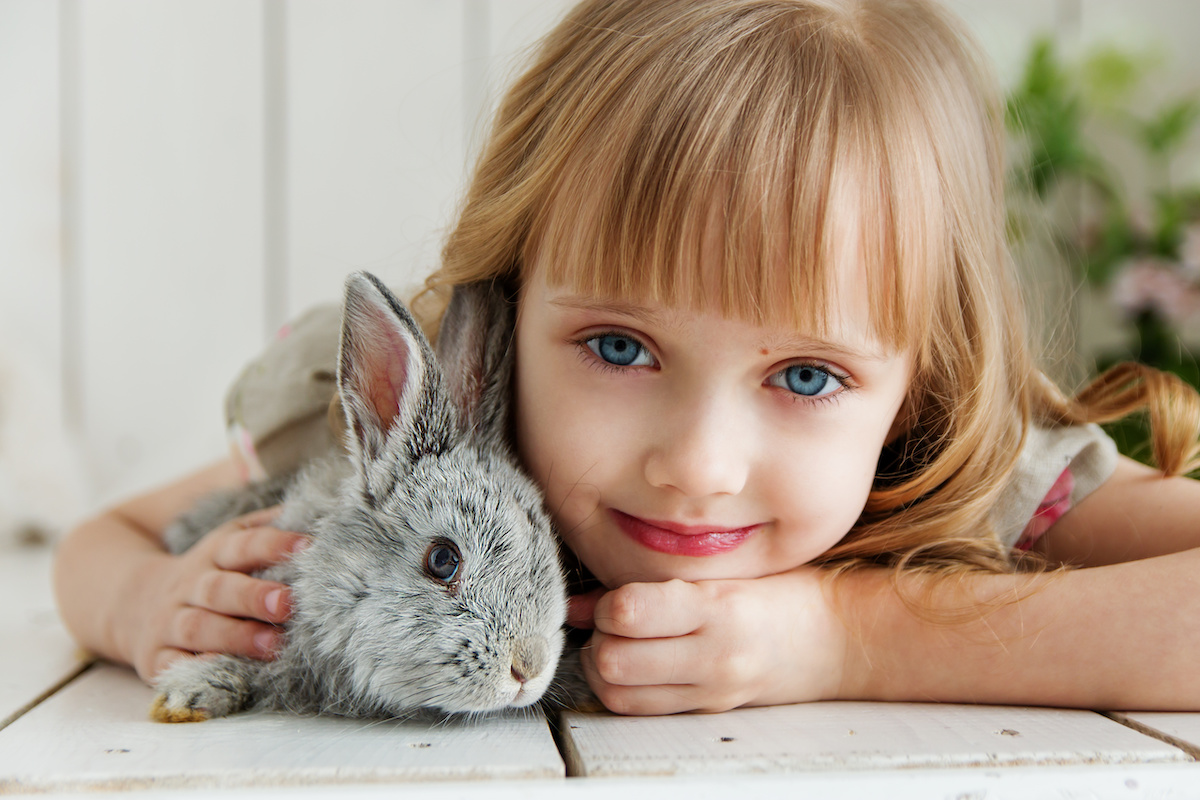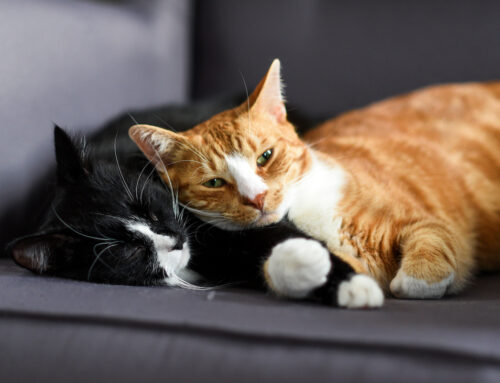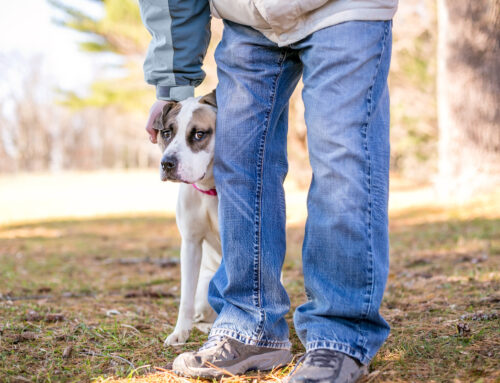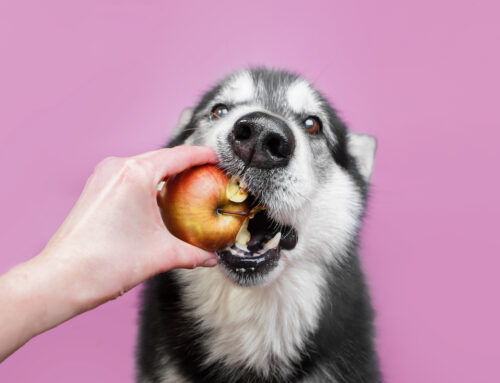With the Easter holiday behind us, you or your kids may be the proud owner of a brand new pet bunny. Bunnies are cute, but it’s important to know how to properly care for them. Are you wondering how to take care of a pet rabbit? What supplies do you need? What kind of food is best?
With a little bit of know-how and a few simple tips, rabbits can be the perfect addition to your home and a great friend for your family. Here’s everything you need to know about how to care for a pet rabbit.
Is it a Good Idea to Get a Pet Rabbit?
Bunnies are cute, but they don’t make great first-time pets. They can be sweet, but they’re also highly sensitive and easily stressed. Unlike dogs and cats, they don’t bark or roll over for belly rubs. Some may not even like you to handle them very much at all.
If you’re thinking about adopting a rabbit, there are a couple of things to keep in mind. First, rabbits are very social creatures and should be at least pairs or trios. A single rabbit may also be lonely and crave the companionship of another rabbit or a furry critter.
Second, you need to have the time and patience to care for a rabbit. Rabbits have grooming and care requirements to keep them clean and healthy. For example, they need to be brushed, combed, and their cage needs to be cleaned regularly.
What is the Life Expectancy of a Pet Rabbit?
While you’re probably going to fall in love with your rabbit, the life expectancy of a pet rabbit is only about five years. Just like any other pet, they need regular veterinary visits to ensure they are healthy. Rabbits are prone to many health problems, including obesity, dental disease, urinary tract infections, and upper respiratory infections.
A rabbit’s life isn’t very long, but it’s full of love. Rabbits can be active and playful, and they enjoy exploring their environment. Most interact with their caretakers and love a world of toys and enrichment.
Healthy, active rabbits are more resistant to many of the health problems that plague rabbit owners, and their lifespan can be extended by providing a high-quality diet and an enriched environment.
What Does a Healthy Rabbit Look Like?
Healthy rabbits should have shiny fur, clean ears, bright eyes, and a dry twitchy nose. They should also have strong legs and a healthy appetite. These bunnies are active, playful, energetic, and curious.
Signs of poor health include:
- Foul odor, like bad breath or smelly ears
- Obesity or malnourishment
- Diarrhea
- Scruffy fur
- Hunched posture
- Listlessness, lethargy, or disinterest in their environment
When you take your bunny to the vet, they should have a clean bill of health, including a clear diagnosis and a plan of treatment if they are sick.

What Should You Feed a Pet Rabit?
Rabbits are herbivores, which means they eat plant-based diets. They are considered “grazers” because they eat little bits at a time throughout the day, rather than enjoying specific meal times.
Unlike dogs and cats, which are omnivores and can thrive on a more varied diet, rabbits should only be fed rabbit-safe vegetables, plants, grasses, and hays. This is because their digestive systems are only designed to break down and absorb these plants. Feeding your rabbit a healthy, balanced diet will ensure that they have the nutrients they need to stay healthy.
Here are a few tips to maintain a healthy diet for your bunny:
- Grass hays such as Timothy, orchard, or brome should make up the majority of your rabbit’s diet.
- Dark leafy greens like romaine lettuce, mustard greens, cilantro, and basil can also be given freely.
- Plants high in calcium such as dandelion greens, parsley, and escarole, can lead to bladder stones so they should be limited. Although years of cartoons have taught us otherwise- carrots should also be given sparingly because they are high in carbohydrates.
- Rabbits should never be given avocados, chocolate, seeds/pits, onions, garlic, rhubarb, meat, dairy, eggs, or beans.
Rabbit Diet Tips
There are a few things to keep in mind when it comes to feeding your rabbit. First, if your rabbit is indoor-only, you need to be careful about what you feed them.
Rabbits who are fed only or mostly vegetables are at risk of developing GI disease, a potentially life-threatening condition. Healthy rabbits also need fiber in their diets to avoid constipation. The two most common types of fiber that are recommended are alfalfa and oat hay.
You’ll also want to provide your bunny with toys and safe chew items to keep their teeth and gums healthy.
Ask your vet for more recommendations on what you can feed your rabbit.
How to Care for a Pet Rabbit: Provide Room for Exercise and Playtime
Rabbits love to chew and explore, so providing them with safe, interesting toys is a great way to give your rabbit enrichment. Provide your rabbit with a comfortable place to chew on toys and or other items. Enrichment items should be safe for rabbits to chew on and free of toxic substances.
Healthy rabbits also require exercise, so make sure to provide them with at least one hour of exercise each day.
Exercise can be provided in many ways. Activities like running on a wheel, digging in a sandbox, or hopping in an exercise pen can provide your rabbit with safe exercise.
Daily activities can also provide your rabbit with exercise. These include running around your house, going for walks in your neighborhood, or playing with a pet friend. If you have a fenced-in yard (check for easy escape routes), this is another great way for your bunny to get some exercise.
Finally, make sure to socialize your rabbit. Not only will this make them more comfortable in their new home, but it will also help them feel more at ease around humans.
What Kind of Cage to Get for a Pet Bunny
If you’re wondering how to take care of a rabbit, you need to consider its cage.
The ideal size for your rabbit cage depends on the size of your rabbit. Your pet rabbit should be able to stand up and turn around in its cage without feeling restricted. Aim to get a cage at least 4 times the size of the rabbit. If your bunny gets too much space, you can always add more toys, hiding spots, or even more bunnies to the household.
You can buy a rabbit cage at most pet stores or online retailers. The cage should be made of wire or plastic and have a secure, escape-proof door. However, refrain from using a cage with a wire floor, which can hurt your rabbit’s feet and cause sores.
The cage should be spacious enough for your rabbit to stand up comfortably and move around freely. The ideal cage size depends on your rabbit’s size, so keep this in mind when you go to find a new cage for your furry friend.
Vet Care for a Pet Rabbit
When it comes to learning how to care for a pet rabbit, you’ll want to think about vet care requirements as well.
Just like a dog or cat, pet rabbits require regular checkups to make sure they’re healthy, as well as vaccinations and routine testing to prevent diseases.
What Diseases Can Get Rabbits Get?
Many diseases can affect your rabbit, and some of them can be pretty serious. One of the most common is upper respiratory tract infections.
Symptoms of an upper respiratory tract infection in rabbits include;
- sneezing
- wheezing
- runny nose
- watery eyes
- decreased appetite
- lethargy
These symptoms can be caused by other things, so it’s important to bring your rabbit to the vet if you notice them.
Other diseases that can affect your rabbit include bacteria and protozoa, coccidiosis, parasites, and cancer.
Remember: A Pet Rabbit is More than an Easter Present!
Did you receive or get a pet bunny for Easter? We’re glad to see that you’re researching how to take care of a pet rabbit.
Bunnies can make an adorable Easter surprise but it’s important to remember that it’s a gift that requires daily care for years to come.
If you have questions about caring for pet rabbits, please reach out to the Animal Care Center today.






